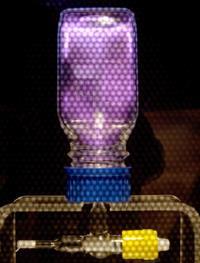Domestic microwave ovens could soon replace expensive radio frequency plasma cleaners used to make microfluidic devices.
Domestic microwave ovens could soon replace expensive radio frequency plasma cleaners used to make microfluidic devices. Researchers at the University of Hong Kong, led by Wing-Tat Chan, have successfully used microwave ovens for the surface plasma treatment of poly(dimethylsiloxane) (PDMS).
PDMS is one of the most commonly used materials for making microfluidic devices; lab-on-a-chip systems that use nano and picolitres of fluid. PDMS is chemically inert to most reagents, has a high breakdown voltage, is transparent to a wavelength of 240nm and most importantly it costs relatively little.

Mass producing chip components is easy; the prepolymer can be cast and then cured on a master template of the desired structure. Devices are then formed by sealing the replica using a flat block of PDMS.
Sealing can be reversible, relying on electrostatic interactions, or irreversible, using chemical bonds. Devices made using the simple and convenient reversible sealing method can only withstand low pressure solution flows. Irreversibly sealed devices can withstand higher pressure solution flows.
Conventionally, PDMS blocks are treated in radio frequency plasma cleaners with an air or oxygen plasma before the two parts of the device are brought into contact. Chan and colleagues have generated plasma in a glass bottle using both domestic and laboratory microwave ovens.
By creating a low-cost system than could be applied to other plasma cleaning or treatment processes, Chan is hopeful that the method will be used by others. ’Every chemistry laboratory can have plasma treatment capability without paying a fortune to get a dedicated system,’ he said.
Rebecca Lavender
References
A Y N Hui et al, Lab Chip, 2005 (DOI:10.1039/<MAN>b504271b</MAN>)






No comments yet